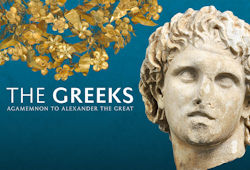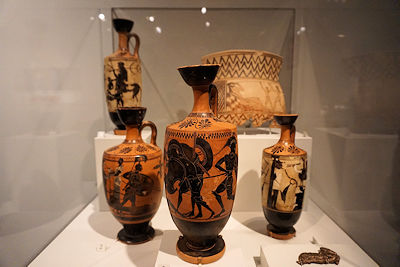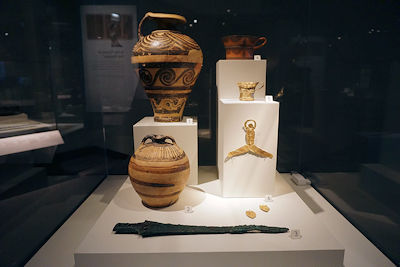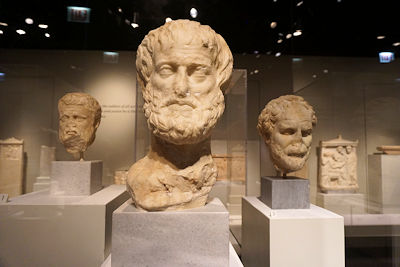
The similarities between the Ancient Greeks and contemporary comic book culture are numerous. Today’s superheroes are essentially modern day equivalents of the Greek gods and goddesses from old, and many of those gods and goddesses have even been incorporated into the works of DC and Marvel. A comparison of written compositions like the The Iliad and The Odyssey with such graphic novels as Watchmen, The Dark Knight Returns, and The Infinity Gauntlet likewise reveals the same DNA running through the classic works of Greeks and Geeks alike.
In 2014, the Pointe-à-Callière Museum of Archaeology and History in Montreal premiered The Greeks: Agamemnon to Alexander the Great, a traveling exhibit featuring over 500 artifacts from twenty-one Greek museums, many of which had never been seen before in North America. The Greeks told the 5,000 year history of a time period often considered the “Birth of Western Civilization,” and while no allusions to Captain America or Superman were contained within, their ancient superhero-like ancestors greeted visitors to the exhibit nonetheless.
The Greeks: Agamemnon to Alexander the Great was divided into six sections, each exploring a different era in the development of Ancient Greece. The first, “the Aegean Prelude,” focused on the Bronze Age and the rise and the fall of the Minoans – a prosperous civilization who lived on the island of Crete until a volcanic eruption on nearby Thera resulted in a series of earthquakes and tsunamis. The natural disaster not only ended Minoan dominance but may also have led to the legend of the lost island of Atlantis.
According to Greek mythology, meanwhile, King Minos of the Minoans refused to sacrifice his best bull to the god Poseidon, who retaliated by cursing the king’s wife into falling in love with the animal. Their eventual union gave birth to a half man, half bull creature called the Minotaur, which Minos – acting on the advice from the oracle at Delphi – kept in a gigantic labyrinth near his palace on Knossos.
Theseus, the later mythical king and founder of Athens, eventually volunteered to enter the labyrinth and kill the Minotaur, freeing his fellow Athenians whom Minos was using to feed the creature in the process.
After the Minoan civilization fell, the Mycenaeans rose to dominate Ancient Greece, a culture more adept at the art of war than the civilized trade conducted by the Minoans. In fact, it was the Mycenaean king Agamemnon who waged a ten-year campaign against the city of Troy after the abduction of his brother’s wife Helen that served as the basis for The Iliad of Homer.
There has been much debate as to whether the central focus of The Iliad – namely the Trojan War itself – was based on historical fact. German archaeologist Heinrich Schliemann was a firm “believer” in fact over fiction, and in the early 1870s uncovered the remains of Troy in the nearby country of Turkey. Determined to find corresponding evidence that the Trojan War actually happened in Greece itself, Schliemann turned his attention to the ancient city of Mycenae, believed to be the burial site of Agamemnon.
Heinrich Schliemann uncovered deep burial chambers at Mycenae. His discoveries even included a human skull wearing a gold death mask that resulted in the archaeologist declaring, “I have gazed upon the face of Agamemnon.” Although modern technology now dates the mask as being from 1600 BC – predating the Trojan War by 400 years – the artifact is still known as the “Mask of Agamemnon” and was featured in The Greeks: Agamemnon to Alexander the Great exhibit along with other items uncovered by Schliemann inside the burial tombs of Mycenae.
While Agamemnon sits on one end of the historical spectrum, on the other resides Alexander the Great. The son of King Philip II of Macedon – who unified Greece through a series of military victories and strategic alliances – Alexander went even further than his father by conquering a large portion of the ancient world, influencing an untold number of civilizations and achieving immortality in the process.
The Greeks: Agamemnon to Alexander the Great included a marble bust of Alexander from the third century BC on loan from the Archaeological Museum of Pella, the ancient Greek city where he was born. “In this depiction, a number of details, supported by rare physical descriptions of Alexander from ancient writings, make it possible to recognize him,” the exhibit stated. “The slight tilt of his head, the arrangement of his hair, his lack of beard – unusual for kings of this period – and his upward glance. The rendering of his hair, his slightly opened mouth, and the working of the marble result in a portrait that is both realistic and idealized.”
In addition to his real-world accomplishments, Alexander the Great also served as the boyhood idol of Adrian Veidt, the superhero Ozymandias and central figure from Alan Moore’s graphic novel Watchmen. At the age of seventeen, Veidt embarked on a vision quest that followed the route of conquest traveled by Alexander over two thousand years earlier, but his visit to Egypt resulted in Adrian Veidt finding a new hero to emulate in the pharaoh Ramesses II.
In between the reigns of Agamemnon and Alexander the Great lies one of the most influential time periods in Western history. It was during this Classical Age that the city of Athens rose to prominence and the first experiments with democracy were undertaken. Athens was also the home of such giants of philosophy as Socrates, Plato, and Aristotle, and it was the era in which the first Olympics were held and the Greek soldier Pheidippides famously ran the 26 miles that separated the battlefield of Marathon from Athens.
As with Alexander the Great, The Greeks exhibit featured marble busts of these legendary figures, including not only Plato and Aristotle but Homer, who transcribed the oral traditions of The Iliad and The Odyssey into the written word. Surrounded by statues and vases, golden wreaths and theater masks, their images tell the story of not only an ancient civilization but the gods and goddesses, heroes and heroines, and kings and queens that are both mythical and legendary.
Western civilization as we know it emerged from Ancient Greece – and one can’t help but notice an influence on comic book characters and contemporary geek cultural as well. From superheroes who resemble the heroes and heroines of Greek mythology, epic narratives similar to The Iliad and The Odyssey, and the influence of kings like Agamemnon and Alexander the Great, the Greeks and the Geeks have more in common than one may realize, with links that date back millenniums.
Anthony Letizia





